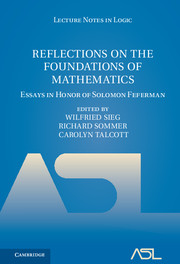Book contents
- Frontmatter
- Preface
- Contents
- PART I PROOF THEORETIC ANALYSIS
- PART II LOGIC AND COMPUTATION
- A pragmatic interpretation of substructural logics
- Computational complexity and induction for partial computable functions in type theory
- Computability theory: structure or algorithms
- Three processes in natural language interpretation
- Infinitary initial algebra specifications for stream algebras
- PART III APPLICATIVE AND SELF-APPLICATIVE THEORIES
- PART IV PHILOSOPHY OF MODERN MATHEMATICAL AND LOGICAL THOUGHT
- Symposium program
- References
Computability theory: structure or algorithms
from PART II - LOGIC AND COMPUTATION
Published online by Cambridge University Press: 31 March 2017
- Frontmatter
- Preface
- Contents
- PART I PROOF THEORETIC ANALYSIS
- PART II LOGIC AND COMPUTATION
- A pragmatic interpretation of substructural logics
- Computational complexity and induction for partial computable functions in type theory
- Computability theory: structure or algorithms
- Three processes in natural language interpretation
- Infinitary initial algebra specifications for stream algebras
- PART III APPLICATIVE AND SELF-APPLICATIVE THEORIES
- PART IV PHILOSOPHY OF MODERN MATHEMATICAL AND LOGICAL THOUGHT
- Symposium program
- References
Summary
In the paper Turing's “oracle”: From absolute to relative computability - and back S.Feferman discusses some major trends in recent work on degrees of unsolvability, theories of recursive functionals and generalized recursion theory and notes how “marching in under the banner of degree theory, these strands were to some extent woven together by the recursion theorists, but the trend has been to pull the subject of effective computability even farther away from questions of actual computation.” (Feferman [1992a])
Feferman had expressed similar concerns in a paper from 1977 Inductive schemata and recursively continuous functionals (Feferman [1977]), and both he and Y. Moschovakis have since pursued a program of how to use “abstract recursion theory as a foundation for a theory of algorithms” (to quote the title of a paper by Moschovakis from 1984). Some key references in the development of this program are Feferman [1991], [1992b], [1996], and Moschovakis [1984], [1989], [1997]. We particularily recommend Feferman [1992b] A new approach to abstract data types, I, Informal development, for a clear conceptual presentation of the issues involved.
I had commented on these issues in the introductory part of the book General Recursion Theory, (Fenstad [1980]). The Oslo group had in the 1970's been active in many parts of generalized recursion theory, such as computation in higher types, inductive definability, continuous functionals, set recursion and other relationships between set theory and recursion theory. We attempted a unified analysis through the axiomatic notion of a computation theory. Our logic group shared the common “world view” of the recursion theory community. We were “inwards bound”, concentrating above all on structure and generality.
It would, however, be wrong to claim that recursion theory in the late 1970'swas all structure and that it paid no attention to questions of algorithmic content. But it was true that our brand of generalized recursion theory was an activity almost exclusively pursued by the logic community. We were running the risk, and this may even be the subtext of Feferman's remarks in 1992, that the inward bound travel toward ever more intricate structural concerns would lead to an academic profession largely irrelevant to computational praxis.
- Type
- Chapter
- Information
- Reflections on the Foundations of MathematicsEssays in Honor of Solomon Feferman, pp. 182 - 207Publisher: Cambridge University PressPrint publication year: 2002
References
- 1
- Cited by

